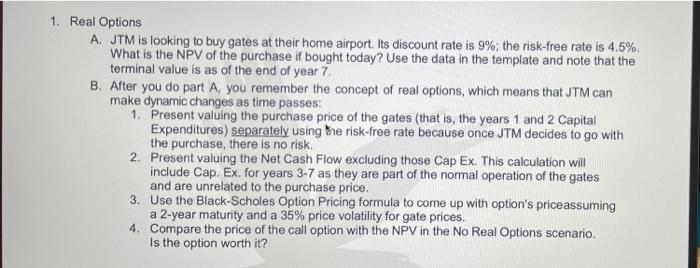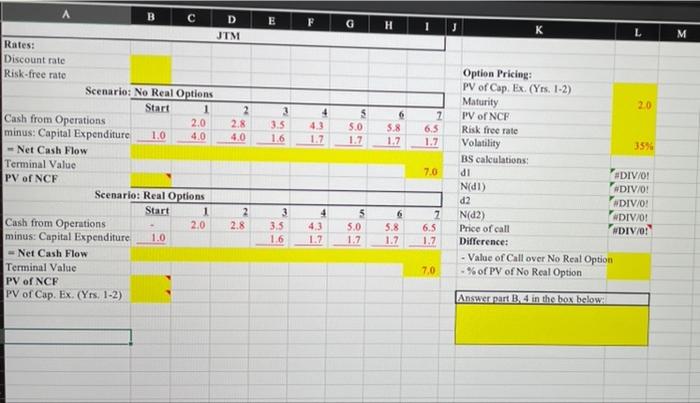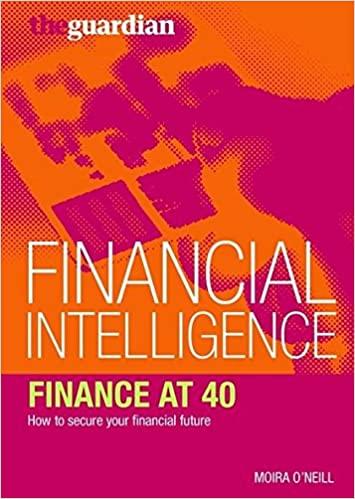1. Real Options A. JTM is looking to buy gates at their home airport. Its discount rate is 9%; the risk-free rate is 4.5%. What is the NPV of the purchase if bought today? Use the data in the template and note that the terminal value is as of the end of year 7. B. After you do part A, you remember the concept of real options, which means that JTM can make dynamic changes as time passes: 1. Present valuing the purchase price of the gates (that is, the years 1 and 2 Capital Expenditures) separately using the risk-free rate because once JTM decides to go with the purchase, there is no risk. 2. Present valuing the Net Cash Flow excluding those Cap Ex. This calculation will include Cap. Ex. for years 3-7 as they are part of the normal operation of the gates and are unrelated to the purchase price. 3. Use the Black-Scholes Option Pricing formula to come up with option's priceassuming a 2-year maturity and a 35% price volatility for gate prices. 4. Compare the price of the call option with the NPV in the No Real Options scenario. Is the option worth it? E F G K L M 3 3.5 1.6 4 4.3 1.7 5 5.0 6 5.8 1.7 Z 6.5 1.7 1.7 D JTM Rates: Discount rate Risk-free rate Scenario: No Real Options Start 2 Cash from Operations 2.0 2.8 minus: Capital Expenditure 1.0 4.0 4.0 Net Cash Flow Terminal Value PV of NCE Scenario: Real Options Start 1 2 Cash from Operations 2.0 2.8 minus: Capital Expenditure 1.0 Net Cash Flow Terminal Value PV of NCF PV of Cap. Ex (Yts, 1-2) 7.0 Option Pricing PV of Cap. Ex. (Yrs. 1-2) Maturity 2.0 PV of NCF Risk free rate Volatility 35% BS calculations: di PUDIV/0! Ndi) #DIV/0! d2 #DIV/0! N(82) WDIV/0! Price of call #DIV/0! Difference: - Value of Call over No Real Option % of PV of No Real Option Answer part B, 4 in the box below: 3 3.5 1.6 5 5.0 1.7 43 1.7 . 6 5.8 1.7 2 6.5 1.2 7.0 1. Real Options A. JTM is looking to buy gates at their home airport. Its discount rate is 9%; the risk-free rate is 4.5%. What is the NPV of the purchase if bought today? Use the data in the template and note that the terminal value is as of the end of year 7. B. After you do part A, you remember the concept of real options, which means that JTM can make dynamic changes as time passes: 1. Present valuing the purchase price of the gates (that is, the years 1 and 2 Capital Expenditures) separately using the risk-free rate because once JTM decides to go with the purchase, there is no risk. 2. Present valuing the Net Cash Flow excluding those Cap Ex. This calculation will include Cap. Ex. for years 3-7 as they are part of the normal operation of the gates and are unrelated to the purchase price. 3. Use the Black-Scholes Option Pricing formula to come up with option's priceassuming a 2-year maturity and a 35% price volatility for gate prices. 4. Compare the price of the call option with the NPV in the No Real Options scenario. Is the option worth it? E F G K L M 3 3.5 1.6 4 4.3 1.7 5 5.0 6 5.8 1.7 Z 6.5 1.7 1.7 D JTM Rates: Discount rate Risk-free rate Scenario: No Real Options Start 2 Cash from Operations 2.0 2.8 minus: Capital Expenditure 1.0 4.0 4.0 Net Cash Flow Terminal Value PV of NCE Scenario: Real Options Start 1 2 Cash from Operations 2.0 2.8 minus: Capital Expenditure 1.0 Net Cash Flow Terminal Value PV of NCF PV of Cap. Ex (Yts, 1-2) 7.0 Option Pricing PV of Cap. Ex. (Yrs. 1-2) Maturity 2.0 PV of NCF Risk free rate Volatility 35% BS calculations: di PUDIV/0! Ndi) #DIV/0! d2 #DIV/0! N(82) WDIV/0! Price of call #DIV/0! Difference: - Value of Call over No Real Option % of PV of No Real Option Answer part B, 4 in the box below: 3 3.5 1.6 5 5.0 1.7 43 1.7 . 6 5.8 1.7 2 6.5 1.2 7.0








